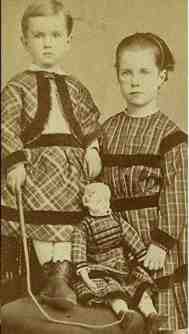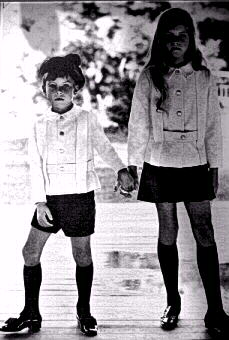
Figure 1.--This brother and sister are wearing coordinated, but not identical tartan outfits dresses. The image looks to have been taken in the 1870s.


Figure 1.--This brother and sister are wearing coordinated, but not identical tartan outfits dresses. The image looks to have been taken in the 1870s. |
Generations of mothers dressed their children, in some cases both sons and daughters, identically or in similar outfits--convinced this was a charming fashion. This was a simple matter in the 18th and much of the 19th Century. As little boys wore dresses just like their sisters, it was easy to ooutfit the boys and girls in identical. At the time it ws considered in appropriate to outfit girls in boys clothes. As distinctive dress styles for little boys developed in the late 19th Century and the fashion of dressing little boys in dresses disappeared after World War I (1914-19), this became more difficult. Many nothers, however, still wanted to dress their children similarly. Thus styles outfits with girls dresses and coordinate boys outfits were developed.
The fashion of dressing brothers and sisters in coordinated
outfits. This usually meant
an older sister and younger brother in the 20th century. I'm not
sure that this convention applied in the 19th Century. But in some
cases in the 19th Century the outfit of an older brother was coordinated
with that of his younger sister. This was less common than in te 20th
Century.
I believe that brothers and sisters in the early 19th Century, especially if close in age, were very commonly dressed alike in identical dresses. This would have continued until the boy was breeched. I have, however, few images to substantiate this.
Many mothers in the late 19th and early 20th century elected to dress their sons and faughters in identical outfits. At the time, some boys were still being outfitted in dresses. Specialized boy dresses had become available by the late 19th Century, but some boys still wore the friller
While boys wore dresses, girls did not wear knee pants. It was, however, virtually unheard of at the time for girls to wear boys' clothes. One never would see, for example, boys and girls wearing identical Little Lord Fauntleroy suits, unless the
boy and girl were wearing Fauntleroy dresses. Brothers and sisters might wear matching sailor outfits, with the boy wearing knee pants and the girl a skirt. However middy blouses worn with
skirts or kilts or actual sailor dresses, were common outfits for young boys. The sister would never wear trousers or knee socks, although younger boys might wear sailor suits with skirts or dresses.
One key factor in dressing brothers and sister alike is the age of the boy. A younger brother would have much less objection to wearing dresses than an older brother. Younger siblings tend to look up to their older siblings. They would be less likely than an older brother to see a dress as something negative to be embarassed about. This was especially true for boys being raised
Some mothers while not dressing their sons and daughters identically, might outfit them in identical smocks. These smocks might be worn while in the nursery or
for play around the home. They would not have normally been worn for outings or for formal occasions. Smocks were particularly common in
France, but were also worn by British and American boys.
Brother-sister dresses may have been most common in France. The fashion of boys wearing dresses seemed to have been more ingrained in France than in other countries. Some mothers put off breching their sons until he was 8 or 9 or even older. Such boys might also be kept in long curls and even wear hair bows. These mights might well be outfitted with their sisters in matching dresses.
I have no details yet on matching outfits at mid-century. Families were mo longer dressed identucally, but many mothers still liked to dress
brothers and sisters identically.
The fashions for brother-sister outfits have now changed considerably. Today a brother-sister outfit would, of course, never have the boy wearing a dress. Commonly the boy wears short pants and the

Figure 5.--This brother and sister wear matching outfits from the early 1970s. The boy wears a beret topped with a pom pom. Notice the Norfolk jackets, a boys' style, but worn with Peter Pan collars. |
One of the best known example of brothers and sisters dressed alike is Ernest Hemmingway in the 1890s. His mother Grace loved to dress him and his older sister in identical frocks. At the time it was not unusual for sometimes quite big boys to wear dresses. Often
the dresses worn by boys would have some boyish touches, perhaps the color or plainer style to identify the boy's gender. Grace Hemmingway, however, dressed Earnest and his sister in absolutely identical outfits.
Since the 1920s the fashion of boys wearing dresses has disappeared. Some mothers, however, still like to dress brothers and sisters alike. The fashion has shifted to outfits with the younger brother wearing a
short pants outfit similar to a dress worn by his older sister.
While the brother-sister matching outfits are usually for an older sister and a younger brother, this was not always the case. Some mothers

Figure 6.--Usually brother sister outfits were for older sisters and younger brothers, but sometimes an older brothers outfit was coordinated with that of his younger sister. |
It has always been most common to dress a younger brother in brother-sister outfits. While this is not always the case, it is the most common. It
seems older brothers are a bit shy about appearing in an outfit similar to their little sisters.
Brother-sister outfits are for the most part dressy outfits. This deoarts from the 19th Century practice of dressing the children alike in smocks or other
identical play clothes. Mothers are less concern today about how the
children dress around the home, but like the brother-sister look for
special events.
Navigate the Boys' Historical Clothing Web Site:
[Return to the Family style page]
[Introduction]
[Chronology]
[Clothing styles]
[Biographies]
[Bibliographies]
[Activities]
[Countries]
[FAQs]
[Fashion messages]
[Contributions]
[Boys' Clothing Home]
